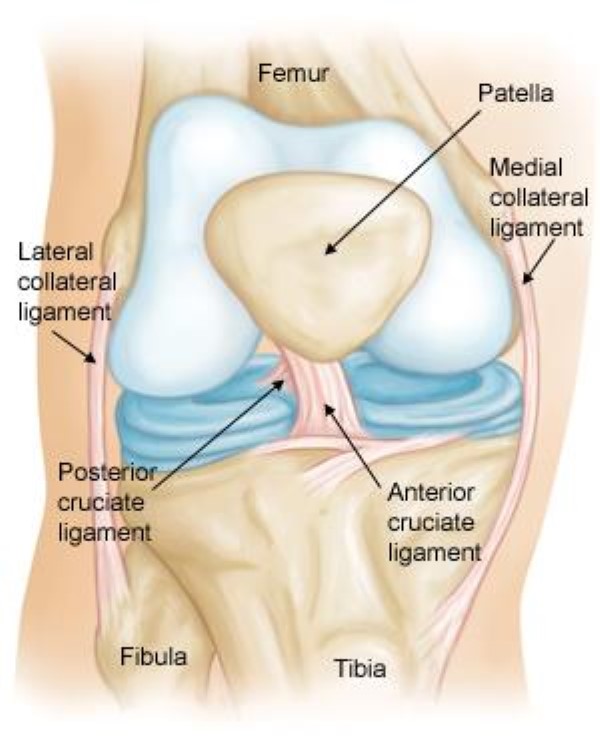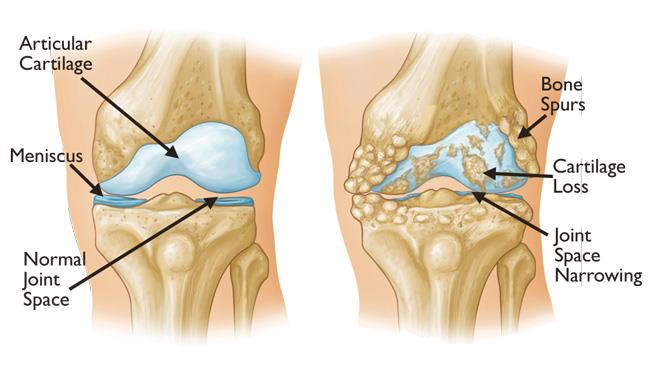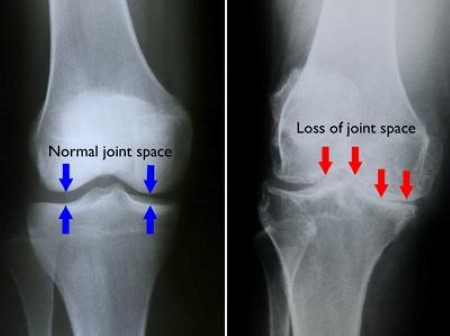Back Conditions Explained
Arthritis of the Knee
We have selected the following expert medical opinion based on its clarity, reliability and accuracy. Credits: Sourced from the website OrthoInfo. Please refer to your own medical practitioner for a final perspective, assessment or evaluation.
What is arthritis of the knee?
Arthritis is inflammation of one or more of your joints. Pain, swelling, and stiffness are the primary symptoms of arthritis. Any joint in the body may be affected by the disease, but it is particularly common in the knee.
Knee arthritis can make it hard to do many everyday activities, such as walking or climbing stairs. It is a major cause of lost work time and a serious disability for many people.
The most common types of arthritis are osteoarthritis and rheumatoid arthritis, but there are more than 100 different forms. While arthritis is mainly an adult disease, some forms affect children.
Although there is no cure for arthritis, there are many treatment options available to help manage pain and keep people staying active.
Anatomy
The knee is the largest and strongest joint in your body. It is made up of the lower end of the femur (thighbone), the upper end of the tibia (shinbone), and the patella (kneecap). The ends of the three bones where they touch are covered with articular cartilage, a smooth, slippery substance that protects and cushions the bones as you bend and straighten your knee.
Two wedge-shaped pieces of cartilage called meniscus act as "shock absorbers" between your thighbone and shinbone. They are tough and rubbery to help cushion the joint and keep it stable.
The knee joint is surrounded by a thin lining called the synovial membrane. This membrane releases a fluid that lubricates the cartilage and reduces friction.
Normal knee anatomy: The knee is made up of four main things: bones, cartilage, ligaments, and tendons.

Description
The major types of arthritis that affect the knee are osteoarthritis, rheumatoid arthritis, and posttraumatic arthritis.
Osteoarthritis
Osteoarthritis is the most common form of arthritis in the knee. It is a degenerative,"wear-and-tear" type of arthritis that occurs most often in people 50 years of age and older, but may occur in younger people, too.
In osteoarthritis, the cartilage in the knee joint gradually wears away. As the cartilage wears away, it becomes frayed and rough, and the protective space between the bones decreases. This can result in bone rubbing on bone, and produce painful bone spurs.
Osteoarthritis develops slowly and the pain it causes worsens over time.
Osteoarthritis often results in bone rubbing on bone. Bone spurs are a common feature of this form of arthritis.

Rheumatoid Arthritis
Rheumatoid arthritis is a chronic disease that attacks multiple joints throughout the body, including the knee joint. It is symmetrical, meaning that it usually affects the same joint on both sides of the body.
In rheumatoid arthritis the synovial membrane that covers the knee joint begins to swell, This results in knee pain and stiffness.
Rheumatoid arthritis is an autoimmune disease. This means that the immune system attacks its own tissues. The immune system damages normal tissue (such as cartilage and ligaments) and softens the bone.
Posttraumatic Arthritis
Posttraumatic arthritis is form of arthritis that develops after an injury to the knee. For example, a broken bone may damage the joint surface and lead to arthritis years after the injury. Meniscal tears and ligament injuries can cause instability and additional wear on the knee joint, which over time can result in arthritis.
Symptoms
A knee joint affected by arthritis may be painful and inflamed. Generally, the pain develops gradually over time, although sudden onset is also possible.
There are other symptoms, as well:
- The joint may become stiff and swollen, making it difficult to bend and straighten the knee.
- Pain and swelling may be worse in the morning, or after sitting or resting.
- Vigorous activity may cause pain to flare up.
- Loose fragments of cartilage and other tissue can interfere with the smooth motion of joints. The knee may "lock" or "stick" during movement. It may creak, click, snap or make a grinding noise (crepitus).
- Pain may cause a feeling of weakness or buckling in the knee.
- Many people with arthritis note increased joint pain with rainy weather.
Doctor Examination
During your appointment, your doctor will talk with you about your symptoms and medical history, conduct a physical examination, and possibly order diagnostic tests, such as x-rays or blood tests.
Physical Examination
During the physical examination, your doctor will look for:
- Joint swelling, warmth, or redness
- Tenderness about the knee
- Range of passive (assisted) and active (self-directed) motion
- Instability of the joint
- Crepitus (a grating sensation inside the joint) with movement
- Pain when weight is placed on the knee
- Problems with your gait (the way you walk)
- Any signs of injury to the muscles, tendons, and ligaments surrounding the knee
- Involvement of other joints (an indication of rheumatoid arthritis)
Imaging Tests
- X-rays: These imaging tests create detailed pictures of dense structures, like bone. They can help distinguish among various forms of arthritis. X-rays of an arthritic knee may show a narrowing of the joint space, changes in the bone and the formation of bone spurs (osteophytes).
- Other tests: Occasionally, a magnetic resonance imaging (MRI) scan, a computed tomography (CT) scan, or a bone scan may be needed to determine the condition of the bone and soft tissues of your knee.
(Left) In this x-ray of a normal knee, the space between the bones indicates healthy cartilage (arrows). (Right) This x-ray of an arthritic knee shows severe loss of joint space.

Laboratory Tests
Your doctor may also recommend blood tests to determine which type of arthritis you have. With some types of arthritis, including rheumatoid arthritis, blood tests will help with a proper diagnosis.
Treatment
There is no cure for arthritis but there are a number of treatments that may help relieve the pain and disability it can cause.
Nonsurgical Treatment
As with other arthritic conditions, initial treatment of arthritis of the knee is nonsurgical. Your doctor may recommend a range of treatment options.
Lifestyle modifications
Some changes in your daily life can protect your knee joint and slow the progress of arthritis.
- Minimize activities that aggravate the condition, such as climbing stairs.
- Switching from high impact activities (like jogging or tennis) to lower impact activities (like swimming or cycling) will put less stress on your knee.
- Losing weight can reduce stress on the knee joint, resulting in less pain and increased function.
Physical therapy
Specific exercises can help increase range of motion and flexibility, as well as help strengthen the muscles in your leg. Your doctor or a physical therapist can help develop an individualized exercise program that meets your needs and lifestyle.
Assistive devices
Using devices such as a cane, wearing shock-absorbing shoes or inserts, or wearing a brace or knee sleeve can be helpful. A brace assists with stability and function, and may be especially helpful if the arthritis is centered on one side of the knee. There are two types of braces that are often used for knee arthritis: An "unloader" brace shifts weight away from the affected portion of the knee, while a "support" brace helps support the entire knee load.
Other remedies
Applying heat or ice, using pain-relieving ointments or creams, or wearing elastic bandages to provide support to the knee may provide some relief from pain.
Medications
Several types of drugs are useful in treating arthritis of the knee. Because people respond differently to medications, your doctor will work closely with you to determine the medications and dosages that are safe and effective for you.
- Over-the-counter, non-narcotic pain relievers and anti-inflammatory medications are usually the first choice of therapy for arthritis of the knee. Acetaminophen is a simple, over-the-counter pain reliever that can be effective in reducing arthritis pain.
Like all medications, over-the-counter pain relievers can cause side effects and interact with other medications you are taking. Be sure to discuss potential side effects with your doctor. - Another type of pain reliever is a nonsteroidal anti-inflammatory drug, or NSAID (pronounced "en-said"). NSAIDs, such as ibuprofen and naproxen, are available both over-the-counter and by prescription.
- A COX-2 inhibitor is a special type of NSAID that may cause fewer gastrointestinal side effects. Common brand names of COX-2 inhibitors include Celebrex (celecoxib) and Mobic (meloxicam, which is a partial COX-2 inhibitor). A COX-2 inhibitor reduces pain and inflammation so that you can function better. If you are taking a COX-2 inhibitor, you should not use a traditional NSAID (prescription or over-the-counter). Be sure to tell your doctor if you have had a heart attack, stroke, angina, blood clot, hypertension, or if you are sensitive to aspirin, sulfa drugs or other NSAIDs.
- Corticosteroids (also known as cortisone) are powerful anti-inflammatory agents that can be injected into the joint These injections provide pain relief and reduce inflammation; however, the effects do not last indefinitely. Your doctor may recommend limiting the number of injections to three or four per year, per joint, due to possible side effects.
In some cases, pain and swelling may "flare" immediately after the injection, and the potential exists for long-term joint damage or infection. With frequent repeated injections, or injections over an extended period of time, joint damage can actually increase rather than decrease. - Disease-modifying anti-rheumatic drugs (DMARDs) are used to slow the progression of rheumatoid arthritis. Drugs like methotrexate, sulfasalazine, and hydroxychloroquine are commonly prescribed.
In addition, biologic DMARDs like etanercept (Enbrel) and adalimumab (Humira) may reduce the body's overactive immune response. Because there are many different drugs today for rheumatoid arthritis, a rheumatology specialist is often required to effectively manage medications. - Viscosupplementation involves injecting substances into the joint to improve the quality of the joint fluid.
- Glucosamine and chondroitin sulfate, substances found naturally in joint cartilage, can be taken as dietary supplements. Although patient reports indicate that these supplements may relieve pain, there is no evidence to support the use of glucosamine and chondroitin sulfate to decrease or reverse the progression of arthritis.
In addition, the U.S. Food and Drug Administration does not test dietary supplements before they are sold to consumers. These compounds may cause side effects, as well as negative interactions with other medications. Always consult your doctor before taking dietary supplements.
Alternative therapies
Many alternative forms of therapy are unproven, but may be helpful to try, provided you find a qualified practitioner and keep your doctor informed of your decision. Alternative therapies to treat pain include the use of acupuncture and magnetic pulse therapy.
Acupuncture uses fine needles to stimulate specific body areas to relieve pain or temporarily numb an area. Although it is used in many parts of the world and evidence suggests that it can help ease the pain of arthritis, there are few scientific studies of its effectiveness. Be sure your acupuncturist is certified, and do not hesitate to ask about his or her sterilization practices.
Magnetic pulse therapy is painless and works by applying a pulsed signal to the knee, which is placed in an electromagnetic field. Like many alternative therapies, magnetic pulse therapy has yet to be proven.
Surgical Treatment
Your doctor may recommend surgery if your pain from arthritis causes disability and is not relieved with nonsurgical treatment. As with all surgeries, there are some risks and possible complications with different knee procedures. Your doctor will discuss the possible complications with you before your operation.
Arthroscopy
During arthroscopy, doctors use small incisions and thin instruments to diagnose and treat joint problems.
Arthroscopic surgery is not often used to treat arthritis of the knee. In cases where osteoarthritis is accompanied by a degenerative meniscal tear, arthroscopic surgery may be recommended to treat the torn meniscus.
Cartilage grafting
Normal, healthy cartilage tissue may be taken from another part of the knee or from a tissue bank to fill a hole in the articular cartilage. This procedure is typically considered only for younger patients who have small areas of cartilage damage.
Synovectomy
The joint lining damaged by rheumatoid arthritis is removed to reduce pain and swelling.
Osteotomy
In a knee osteotomy, either the tibia (shinbone) or femur (thighbone) is cut and then reshaped to relieve pressure on the knee joint. Knee osteotomy is used when you have early-stage osteoarthritis that has damaged just one side of the knee joint. By shifting your weight off the damaged side of the joint, an osteotomy can relieve pain and significantly improve function in your arthritic knee.
Total or partial knee replacement (arthroplasty)
Your doctor will remove the damaged cartilage and bone, and then position new metal or plastic joint surfaces to restore the function of your knee.
(Left) A partial knee replacement is an option when damage is limited to just one part of the knee. (Right) A total knee replacement prosthesis.

Recovery
After any type of surgery for arthritis of the knee, there is a period of recovery. Recovery time and rehabilitation depends on the type of surgery performed.
Your doctor may recommend physical therapy to help you regain strength in your knee and to restore range of motion. Depending upon your procedure, you may need to wear a knee brace, or use crutches or a cane for a time.
In most cases, surgery relieves pain and makes it possible to perform daily activities more easily.
Recommended Websites
For further information, go to:
_______________________________________________________________________________________________________________________
Are you a healthcare practitioner who enjoys patient education, interaction and communication?
If so, we invite you to criticise, contribute to or help improve our content. We find that many practicing doctors who regularly communicate with patients develop novel and often highly effective ways to convey complex medical information in a simplified, accurate and compassionate manner.
MedSquirrel is a shared knowledge, collective intelligence digital platform developed to share medical expertise between doctors and patients. We support collaboration, as opposed to competition, between all members of the healthcare profession and are striving towards the provision of peer reviewed, accurate and simplified medical information to patients. Please share your unique communication style, experience and insights with a wider audience of patients, as well as your colleagues, by contributing to our digital platform.
Your contribution will be credited to you and your name, practice and field of interest will be made visible to the world. (Contact us via the orange feed-back button on the right).
Disclaimer:
MedSquirrel is a shared knowledge, collective intelligence digital platform developed to share medical knowledge between doctors and patients. If you are a healthcare practitioner, we invite you to criticise, contribute or help improve our content. We support collaboration among all members of the healthcare profession since we strive for the provision of world-class, peer-reviewed, accurate and transparent medical information.
MedSquirrel should not be used for diagnosis, treatment or prescription. Always refer any questions about diagnosis, treatment or prescription to your Doctor.
